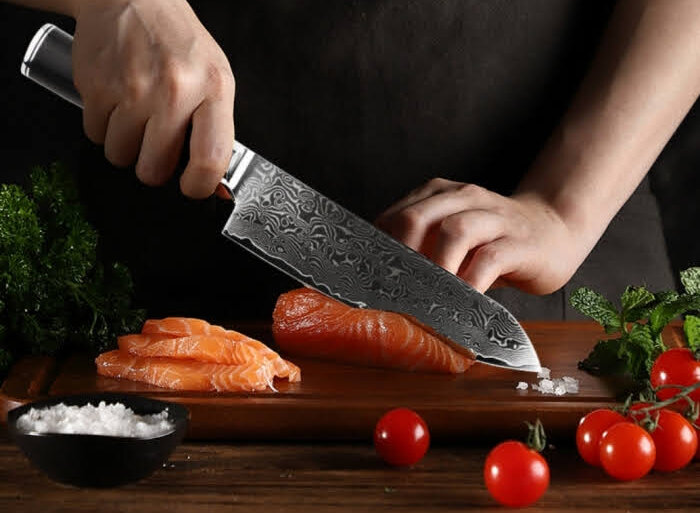Damascus knives are not only exquisite pieces of craftsmanship but also essential tools appreciated by culinary professionals for their exceptional cutting performance and striking designs. Renowned for their distinctive wavy patterns, these knives are forged by layering and folding various types of steel. It's crucial to grasp the nuances of these knives, especially when it comes to sharpening Damascus knives properly. Striking the right balance between preserving their captivating aesthetics and optimizing performance is key.
In this guide, we'll explore the detailed process of sharpening these extraordinary blades, equipping you with the knowledge needed to maintain their sharp edge and beautiful finish. Whether you're a professional chef or an avid home cook, refining your sharpening skills will elevate your culinary techniques and enhance the lifespan of your prized knives.

The Intricate Art of Damascus Steel
The tradition of Damascus steel craftsmanship dates back many centuries, rooted in both metallurgy and artistry. The beautiful patterns serve a purpose beyond mere aesthetics; they reveal the intricate history of steel-making, blending layers of hard and soft steel to create knives that are as resilient as they are stunning. To gain deeper insight, visit The Long History of Damascus Knives.
This unique construction demands a tailored approach to sharpening. Unlike standard blades, the edges of Damascus knives are often more brittle, necessitating a gentler and more deliberate technique. Incorrect sharpening methods can not only lead to a dull edge but also risk damaging the beautiful pattern that distinguishes Damascus knives from others.
Essential Tools for Sharpening Damascus Knives
To achieve optimal results when sharpening Damascus knives, it's vital to have the right tools on hand. Here's what you'll need:
Whetstones: Choose high-quality whetstones with varying grit levels, starting with a coarser grit (around 1000) and gradually moving to finer grits (up to 8000) for a polished edge.
Honing Steel: Regular honing helps realign the blade's edge, keeping it sharp between sharpenings without removing metal.
Leather Strop: This is essential for polishing and refining the edge post-sharpening, improving both performance and durability.
Step-by-Step Sharpening Guide
Step 1: Preparing the Whetstone
Before you start, ensure your whetstone is soaked in water (if its a water stone) or properly lubricated (for oil stones).
Stability is crucialplace a wet cloth beneath the stone to prevent it from slipping during the sharpening process.
Step 2: Establishing the Angle
Most Damascus knives should be sharpened at an angle of 15 to 20 degrees. Consistently holding this angle is essential to preserving the blade's integrity.
If you're uncertain about maintaining the correct angle, using knife guides can be helpful, especially for beginners.
Step 3: Sharpening the Edge
Begin with the coarser grit on your whetstone. Maintain the established angle and gently draw the blade across the stone in a sweeping motion, applying even pressure along the entire edge.
Repeat this motion until a burr develops on the opposite side, indicating your edge is sharpening properly.
Step 4: Finishing Touches
Switch to a finer grit stone to polish the edge, repeating the same sweeping motion until you achieve a smooth, razor-sharp edge.
Conclude the sharpening process with a leather strop to eliminate any lingering burrs, giving your knife a sharp, polished finish.
Maintaining Your Damascus Knife
After sharpening, the ongoing maintenance of your Damascus knife is essential to preserving both its functionality and visual appeal. Regular honing with a steel will help sustain the edges sharpness. Furthermore, proper storage away from moisture and humidity is crucial to prevent corrosion.
For comprehensive care instructions for Damascus knives, check out this resource, which provides valuable tips for extending the lifespan of your knives.

Frequently Asked Questions
What is the best angle to sharpen a Damascus knife?
A 15 to 20-degree angle is recommended for most Damascus knives, striking the right balance between sharpness and longevity.
Why is my Damascus knife becoming dull quickly?
Using poor sharpening techniques or the wrong angle can cause rapid dulling. Regular honing and using a leather strop will help keep it sharper for longer.
Can I use a mechanical sharpener for Damascus knives?
It is advisable to avoid mechanical sharpeners, as they can be excessively abrasive and potentially damage the knife's pattern and edge.
For more insights on the beauty and utility of these unique knives, explore Damascus Knives for Collectors or Damascus Knives for Professionals.
Enhance your knowledge by checking out our article on Damascus Knives for Culinary Students.
This article contains affiliate links. We may earn a commission at no extra cost to you.


























